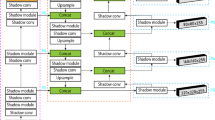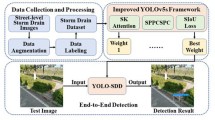Abstract
Timely and accurately estimating ponding levels during urban floods is the basis of effective disaster prevention and mitigation. Road surveillance videos record the urban flood process as images, and computer vision technology brings new opportunities for extracting ponding information from image data. This study proposes a computer vision-based method for estimating the spatial-temporal distribution of urban street ponding levels from surveillance videos. First, a dataset of sedan images compiled from three sources was collected to train an object detection algorithm, You Only Look Once vision 3 (YOLOv3). Then, the trained model was adopted to identify the ponding levels whenever and wherever sedans were detected from the videos. Second, outlier detection was employed to detect and delete the outliers of ponding levels in each time step. Finally, the ponding level distribution was estimated by inverse distance weighted from the remaining ponding level points. This method was employed for two pluvial flood events at a street crossing, Dongguan Street, in Dalian, China. The mean average precision (mAP) of the trained YOLOv3 model reached 78%, which confirmed the validity of the model. The ponding levels estimated by our method were validated with the submerged depth of a static reference, and the ponding process had a strong correlation with the rainfall time series. Outlier detection improved the accuracy of ponding level estimation in cross-validation to 88% on average. The results can be used to analyze the progress of urban flood evolution, which contributes to arranging drainage facilities and improving urban flood management.









Similar content being viewed by others
Availability of data and material
The models and code that support the findings of this study are available from the corresponding author upon reasonable request.
References
Akter T, Gazi MY, Mia MB (2021) Assessment of Land Cover Dynamics, Land Surface Temperature, and Heat Island Growth in Northwestern Bangladesh Using Satellite Imagery. Environ Processes 8(2):661–690. https://doi.org/10.1007/s40710-020-00491-y
Alizadeh Kharazi B, Behzadan AH (2021) Flood depth map** in street photos with image processing and deep neural networks. Comput Environ Urban Syst 88:101628. https://doi.org/10.1016/j.compenvurbsys.2021.101628
Anselin L (1995) Local Indicators of Spatial Association-LISA. GEOGR ANAL 27(2):93–115
Arabameri A, Arora A, Pal SC, Mitra S, Saha A, Nalivan OA, Panahi S, Moayedi H (2021) K-Fold and State-of-the-Art Metaheuristic Machine Learning Approaches for Groundwater Potential Modelling. WATER RESOUR MANAG 35(6):1837–1869. https://doi.org/10.1007/s11269-021-02815-5
Batty M, Axhausen KW, Giannotti F, Pozdnoukhov A, Bazzani A, Wachowicz M, Ouzounis G, Portugali Y (2012) Smart cities of the future. Eur Phys J Special Top 214(1):481–518. https://doi.org/10.1140/epjst/e2012-01703-3
Chaudhary P, Aronco D, Moy De Vitry S, Leitão M, Wegner JP (2019) JD. FLOOD-WATER LEVEL ESTIMATION FROM SOCIAL MEDIA IMAGES. ISPRS annals of the photogrammetry, remote sensing and spatial information sciences, IV-2/W5, 5–12. https://doi.org/10.5194/isprs-annals-IV-2-W5-5-2019
Feng Y, Brenner C, Sester M (2020) Flood severity map** from Volunteered Geographic Information by interpreting water level from images containing people: A case study of Hurricane Harvey. ISPRS J PHOTOGRAMM 169:301–319. https://doi.org/10.1016/j.isprsjprs.2020.09.011
Gaus YFA, Bhowmik N, Akcay S, Breckon T (2019) Evaluating the transferability and adversarial discrimination of convolutional neural networks for threat object detection and classification within x-ray security imagery. In 2019 18th IEEE International Conference On Machine Learning And Applications (ICMLA) (pp. 420–425). IEEE
Jafari NH, Li X, Chen Q, Le C, Betzer LP, Liang Y (2021) Real-time water level monitoring using live cameras and computer vision techniques. COMPUT GEOSCI-UK 147:104642. https://doi.org/10.1016/j.cageo.2020.104642
Jiang J, Liu J, Cheng C, Huang J, Xue A (2019) Automatic Estimation of Urban Waterlogging Depths from Video Images Based on Ubiquitous Reference Objects. REMOTE SENS-BASEL 11(5):587. https://doi.org/10.3390/rs11050587
Jiang J, Qin C, Yu J, Cheng C, Liu J, Huang J (2020) REMOTE SENS-BASEL 12(6):1014. https://doi.org/10.3390/rs12061014. Obtaining Urban Waterlogging Depths from Video Images Using Synthetic Image Data
Joint II, Groom SB (2000) Estimation of phytoplankton production from space: current status and future potential of satellite remote sensing. J EXP MAR BIOL ECOL 250(1–2):233–255. https://doi.org/10.1016/s0022-0981(00)00199-4
Li T, Jiang C, Bian Z, Wang M, Niu X (2020) Semantic Segmentation of Urban Street Scene Based on Convolutional Neural Network. In Journal of Physics: Conference Series (Vol. 1682, No. 1, p. 012077). IOP Publishing
Lim C, Kim K, Maglio PP (2018) Smart cities with big data: Reference models, challenges, and considerations. Cities 82:86–99. https://doi.org/10.1016/j.cities.2018.04.011
Martinez-Alpiste, I., Golcarenarenji, G., Wang, Q., & Alcaraz-Calero, J. M. (2021). A dynamic discarding technique to increase speed and preserve accuracy for YOLOv3. Neural Computing and Applications, 33(16), 9961–9973.
Redmon, J., & Farhadi, A. (2018). Yolov3: An incremental improvement. ar** using social media, remote sensing and topographic data. NAT HAZARDS 87(1):103–120. https://doi.org/10.1007/s11069-017-2755-0
Sakaino H (2016) Camera-Vision-Based Water Level Estimation. IEEE SENS J 16(21):7564–7565. https://doi.org/10.1109/JSEN.2016.2603524
Sharma SK, Seetharaman A, Maddulety K (2021) Framework for Sustainable Urban Water Management in Context of Governance, Infrastructure, Technology and Economics. WATER RESOUR MANAG 35(12):3903–3913. https://doi.org/10.1007/s11269-021-02916-1
Tabari H (2020) Climate change impact on flood and extreme precipitation increases with water availability. Sci Rep 10(1):1–10
Wang J, Hu C, Ma B, Mu X (2020) Rapid Urbanization Impact on the Hydrological Processes in Zhengzhou, China. WATER-SUI 12(7):1870. doi: https://doi.org/10.3390/w12071870
Wang R, Mao H, Wang Y, Rae C, Shaw W (2018) COMPUT GEOSCI-UK 111(C):139–147. https://doi.org/10.1016/j.cageo.2017.11.008. Hyper-resolution monitoring of urban flooding with social media and crowdsourcing data
Wang Y, Di Sabatino S, Martilli A, Li Y, Wong MS, Gutiérrez E, Chan PW (2017) Impact of land surface heterogeneity on urban heat island circulation and sea-land breeze circulation in Hong Kong. J Geophys Research: Atmos 122(8):4332–4352. https://doi.org/10.1002/2017JD026702
Watson, D. F. and Philip, G. M. (1985) A refinement of inverse distance weighted interpolation. Geoprocessing 2:315–327.
Witherow MA, Sazara C, Winter-Arboleda IM, Elbakary MI, Cetin M, Iftekharuddin KM (2019) Floodwater detection on roadways from crowdsourced images. Comput Methods Biomech Biomedical Engineering: Imaging Visualization 7(5–6):529–540. https://doi.org/10.1080/21681163.2018.1488223
Wu Z, Zhou Y, Wang H, Jiang Z (2020) Depth prediction of urban flood under different rainfall return periods based on deep learning and data warehouse. SCI TOTAL ENVIRON 716:137077. https://doi.org/10.1016/j.scitotenv.2020.137077
Yu J, Hahn H (2010) Remote Detection and Monitoring of a Water Level Using Narrow Band Channel. J Inf Sci Eng 26(1):71–82
Funding
This research was funded by the National Outstanding Youth Science Fund Project of National Natural Science Foundation of China, grant number 51925902, and the Fund of Innovation Research Team from the Department of Science and Technology in Liaoning Province, grant number XLYC1908023. The authors thank the anonymous reviewers for their valuable comments.
Author information
Authors and Affiliations
Contributions
**n Hao collected the data, performed the calculations, and wrote the first manuscript. Heng Lyu conceived the original idea, helped supervise the study and revised the manuscript. Ze Wang and Shengnan Fu helped carry out the calculations and collect the data. Chi Zhang supervised the project. All authors discussed the results and contributed to the final manuscript.
Corresponding author
Ethics declarations
Ethical Approval
This article does not contain any studies with human participants or animals performed by any of the authors.
Conflict of interest
The authors declare that there is no conflict of interest.
Consent to Participate
The authors declare that have consent to participate and consent to publish.
Additional information
Publisher’s Note
Springer Nature remains neutral with regard to jurisdictional claims in published maps and institutional affiliations.
Rights and permissions
About this article
Cite this article
Hao, X., Lyu, H., Wang, Z. et al. Estimating the spatial-temporal distribution of urban street ponding levels from surveillance videos based on computer vision. Water Resour Manage 36, 1799–1812 (2022). https://doi.org/10.1007/s11269-022-03107-2
Received:
Accepted:
Published:
Issue Date:
DOI: https://doi.org/10.1007/s11269-022-03107-2




